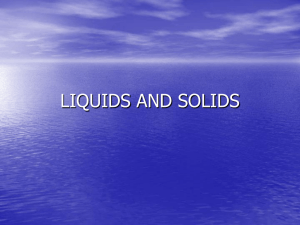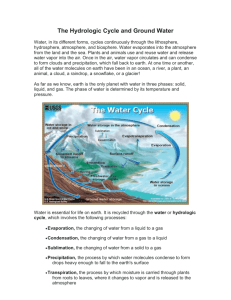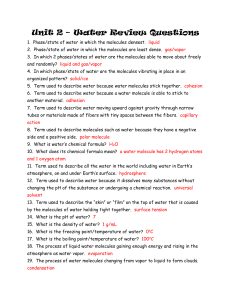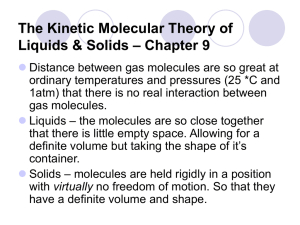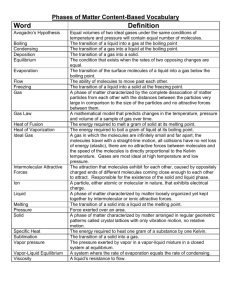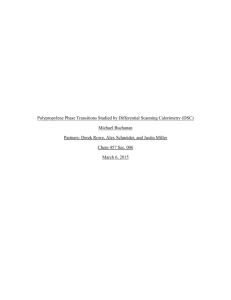critical temperature
advertisement
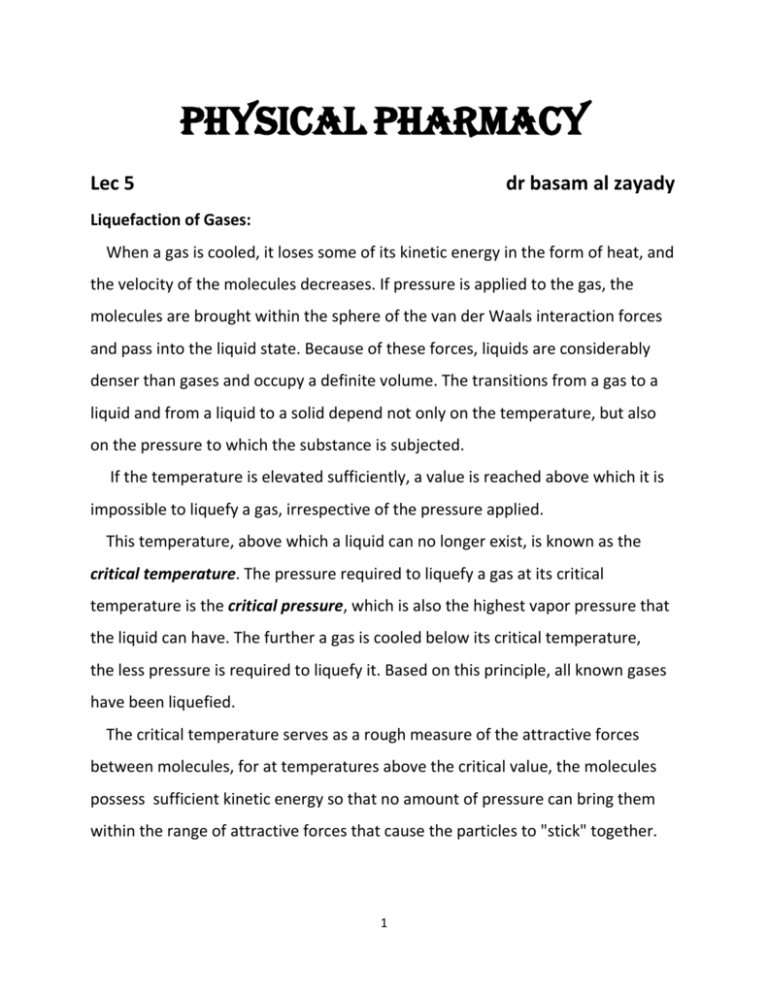
Physical pharmacy Lec 5 dr basam al zayady Liquefaction of Gases: When a gas is cooled, it loses some of its kinetic energy in the form of heat, and the velocity of the molecules decreases. If pressure is applied to the gas, the molecules are brought within the sphere of the van der Waals interaction forces and pass into the liquid state. Because of these forces, liquids are considerably denser than gases and occupy a definite volume. The transitions from a gas to a liquid and from a liquid to a solid depend not only on the temperature, but also on the pressure to which the substance is subjected. If the temperature is elevated sufficiently, a value is reached above which it is impossible to liquefy a gas, irrespective of the pressure applied. This temperature, above which a liquid can no longer exist, is known as the critical temperature. The pressure required to liquefy a gas at its critical temperature is the critical pressure, which is also the highest vapor pressure that the liquid can have. The further a gas is cooled below its critical temperature, the less pressure is required to liquefy it. Based on this principle, all known gases have been liquefied. The critical temperature serves as a rough measure of the attractive forces between molecules, for at temperatures above the critical value, the molecules possess sufficient kinetic energy so that no amount of pressure can bring them within the range of attractive forces that cause the particles to "stick" together. 1 Methods for Achieving Liquefaction: One of the ways to liquefy a gas is to subject it to intense cold by the use of freezing mixtures. Other methods depend on the cooling effect produced in a gas as it expands. Thus, suppose we allow an ideal gas to expand so rapidly that no heat enters the system. Such an expansion, termed an adiabatic expansion, may be achieved by carrying out the process in a vacuum flask, which effectively insulates the contents of the flask from the external environment. The work that has to be done to bring about expansion therefore must come from the gas itself at the expense of its own heat energy content. As a result, the temperature of the gas falls. If this procedure is repeated a sufficient number of times, the total drop in temperature is sufficient to cause liquefaction of the gas. Aerosols: Gases can be liquefied by increasing pressure, provided we work below the critical temperature. When the pressure is reduced, the molecules expand and the liquid reverts to a gas. This reversible change of state is the basic principle involved in the preparation of pharmaceutical aerosols. In such products, the drug is dissolved or suspended in a 'propellant', a material that is liquid under the pressure conditions existing inside the container and forms a gas under normal atmospheric conditions. Chlorofluorocarbons and hydrofluorocarbons have traditionally been utilized as propellants in these products because of their physicochemical properties, However, in the face of increasing environmental concerns (ozone depletion) their use is tightly regulated which has led to the increased use of other gases such as nitrogen and carbon dioxide. 2 Vapor Pressure of Liquids Translational energy of motion (kinetic energy) is not distributed evenly among molecules; some of the molecules have more energy and hence higher velocities than others at any moment. When a liquid is placed in an evacuated container at a constant temperature, the molecules with the highest energies break away from the surface of the liquid and pass into the gaseous state, and some of the molecules subsequently return to the liquid state, or condense. When the rate of condensation equals the rate of vaporization at a definite temperature, the vapor becomes saturated and a dynamic equilibrium is established. The pressure of the saturated vapor above the liquid is then known as the equilibrium vapor pressure. If a manometer is fitted to an evacuated vessel containing the liquid, it is possible to obtain a record of the vapor pressure in millimeters of mercury. The presence of a gas, such as air, above the liquid decreases the rate of evaporation, but it does not affect the equilibrium pressure of the vapor. As the temperature of the liquid is elevated, more molecules approach the velocity necessary for escape and pass into the gaseous state. As a result, the vapor pressure increases with rising temperature. Boiling Point: If a liquid is placed in an opened container and heated until the vapor pressure equals the atmospheric pressure, the vapor is seen to form bubbles that rise rapidly through the liquid and escape into the gaseous state. The temperature at which the vapor pressure of the liquid equals the external or atmospheric pressure is known as the boiling point. Absorbed heat is used to change liquid to vapor, and temperature does not rise until the liquid is completely vaporized. 3 Solids and the Crystalline State Crystalline Solids The structural units of crystalline solids, such as ice, sodium chloride, and menthol, are arranged in fixed geometric patterns or lattices. Crystalline solids, unlike liquids and gases, have definite shapes and an orderly arrangement of units. Gases are easily compressed, whereas solids, like liquids, are practically incompressible. The units that constitute the crystal structure can be atoms, molecules, or ions. The sodium chloride crystal, shown in Figure bellow, consists of a cubic lattice of sodium ions interpenetrated by a lattice of chloride ions, the binding force of the crystal being the electrostatic attraction of the oppositely charged ions. In diamond and graphite, the lattice units consist of atoms held together by covalent bonds. Solid carbon dioxide, hydrogen chloride, and naphthalene form crystals composed of molecules as the building units. The crystal lattice of sodium chloride Polymorphism: It is the case when a substance exists in more than 1 crystalline form but they have the same chemical formula. Differences in the crystalline form may lead to differences in physical properties as melting point, solubility, miscibility and x4 ray diffraction. In case of slightly soluble drugs, this may affect dissolution rate, as a result, one polymorph may be more active therapeutically than another polymorph of the same drug. For example polymorphic state of chloramphenicol palmitate have a significant influence on the biologic availability of the drug. Another case is that of the AIDS drug ritonavir, which was marketed in a dissolved formulation until a previously unknown, more stable and less soluble polymorph appeared. This led to recall of the product from the market. Perhaps the most common example of polymorphism is the contrast between a diamond and graphite, both of which are composed of crystalline carbon. In this case, high pressure and temperature lead to the formation of a diamond from elemental carbon. It should be noted that a diamond is a less stable (metastable) crystalline form of carbon than is graphite. Actually, the imperfections in diamonds continue to occur with time and represent the diamond converting, very slowly at the low ambient temperature and pressure, into the more stable graphite polymorph. Solvates Because many pharmaceutical solids are often synthesized by standard organic chemical methods, purified, and then crystallized out of different solvents, residual solvents can be trapped in the crystalline lattice. This creates a cocrystal termed a solvate. The presence of the residual solvent may dramatically affect the crystalline structure of the solid depending on the types of intermolecular interactions that the solvent may have with the crystalline solid. 5 Amorphous Solids Amorphous solids as a first approximation may be considered supercooled liquids in which the molecules are arranged in a somewhat random manner as in the liquid state. Substances such as glass and many synthetic plastics are amorphous solids. They differ from crystalline solids in that they tend to flow when subjected to sufficient pressure over a period of time, and they do not have definite melting points. Amorphous substances, as well as cubic crystals, are usually isotropic, that is, they exhibit similar properties in all directions. Crystals other than cubic are anisotropic, showing different characteristics (electric conductance, refractive index, crystal growth, rate of solubility) in various directions along the crystal. Whether a drug is amorphous or crystalline has been shown to affect its therapeutic activity. Thus, the crystalline form of the antibiotic novobiocin acid is poorly absorbed and has no activity, whereas the amorphous form is readily absorbed and therapeutically active. This is due to the differences in the rate of dissolution. Once dissolved, the molecules exhibit no memory of their origin. X-Ray Diffraction: X-rays are diffracted by crystals just as visible light is dispersed into a color spectrum by a ruled grating. This is due to the fact that x-rays have wavelengths of about the same magnitude as the distance between the atoms or molecules of crystals (about 1.54 Å for most laboratory instruments using Cu Kα radiation; the C—C bond is about 1.5 Å). Melting Point and Heat of Fusion: The temperature at which a liquid passes into the solid state is known as the freezing point. It is also the melting point of a pure crystalline compound. The 6 freezing point or melting point of a pure crystalline solid is strictly defined as the temperature at which the pure liquid and solid exist in equilibrium. The heat (energy) absorbed when 1 g of a solid melts or the heat liberated when it freezes is known as the latent heat of fusion, and for water at 0°C it is about 80 cal/g (1436 cal/mole). The heat added during the melting process does not bring about a change in temperature until all of the solid has disappeared because this heat is converted into the potential energy of the molecules that have escaped from the solid into the liquid state. Thermal Analysis A number of physical and chemical effects can be produced by temperature changes, and methods for characterizing these alterations upon heating or cooling a sample of the material are referred to as thermal analysis. The most common types of thermal analysis are DSC, differential thermal analysis (DTA), and thermomechanical analysis (TMA). These methods have proved to be valuable in pharmaceutical research and quality control for the characterization and identification of compounds, the determination of purity, polymorphism solvent, and moisture content, amorphous content, stability, and compatibility with excipients. Differential Scanning Calorimetry In DSC, heat flows and temperatures are measured that relate to thermal transitions in materials. Typically, a sample and a reference material are placed in separate pans and the temperature of each pan is increased or decreased at a predetermined rate. When the sample, for example, benzoic acid, reaches its melting point, in this case 122.4°C, it remains at this temperature until all the material has passed into the liquid state because of the endothermic process of 7 melting. A temperature difference therefore exists between benzoic acid and a reference, indium (melting point [mp] = 156.6°C), as the temperature of the two materials is raised gradually through the range 122°C to 123°C. A second temperature circuit is used in DSC to provide a heat input to overcome this temperature difference. In this way the temperature of the sample, benzoic acid, is maintained at the same value as that of the reference, indium. The difference is heat input to the sample, and the reference per unit time is fed to a computer and plotted as dH/dt versus the average temperature to which the sample and reference are being raised. The data collected in a DSC run for a compound such as benzoic acid are shown in the thermogram Figure. Thermogram of a drug compound 8 Differential scanning calorimetry is a measurement of heat flow into and out of the system. In general, an endothermic (the material is absorbing heat) reaction on a DSC arises from desolvations, melting, glass transitions, and, more rarely, decompositions. An exothermic reaction measured by DSC is usually indicative of a decomposition (energy is released from the bond breaking) process and molecular reorganizations such as crystallization. 9


